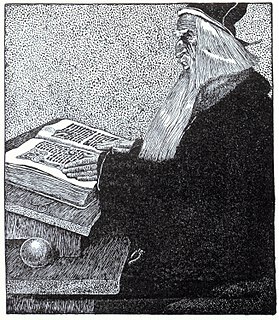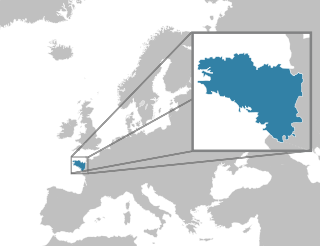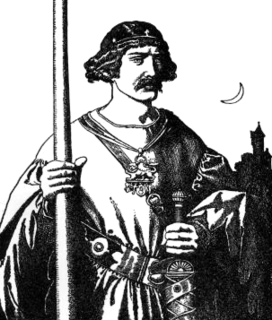
Merlin is a legendary figure best known as an enchanter or wizard featured in Arthurian legend and medieval Welsh poetry The standard depiction of the character first appears in Geoffrey of Monmouth's Historia Regum Britanniae, written c. 1136, and is based on an amalgamation of previous historical and legendary figures. Geoffrey combined existing stories of Myrddin Wyllt, a North Brythonic prophet and madman with no connection to King Arthur, with tales of the Romano-British war leader Ambrosius Aurelianus to form the composite figure he called Merlin Ambrosius.

Brittany is a cultural region in the northwest of France, covering the western part of what was known as Armorica during the period of Roman occupation. It became an independent kingdom and then a duchy before being united with the Kingdom of France in 1532 as a province governed as if it were a separate nation under the crown.

Ille-et-Vilaine is a department of France, located in the region of Brittany in the northwest of the country.
The following is a list and assessment of sites and places associated with King Arthur and the Arthurian legend in general. Given the lack of concrete historical knowledge about one of the most potent figures in British mythology, it is unlikely that any definitive conclusions about the claims for these places will ever be established; nevertheless it is both interesting and important to try to evaluate the body of evidence which does exist and examine it critically. The earliest association with Arthur of many of the places listed is often surprisingly recent, with most southern sites' association based on nothing more than the toponymic speculations of recent authors with a local prejudice to promote.
Red Knight is a title borne by several characters in Arthurian legend.

Tristan and Iseult is an influential romance story, retold in numerous sources with as many variations since the 12th century. The story is a tragedy about the adulterous love between the Cornish knight Tristan (Tristram) and the Irish princess Iseult. The narrative predates and most likely influenced the Arthurian romance of Lancelot and Guinevere, and has had a substantial impact on Western art and literature. While the details of the story differ from one author to another, the overall plot structure remains much the same.

Huelgoat is a commune in the Finistère department of Brittany in northwestern France.

Brocéliande is a legendary enchanted forest that had a reputation in the medieval European imagination as a place of magic and mystery. Brocéliande is featured in several medieval texts, mostly related to the Arthurian legend and the characters of Merlin, Morgan le Fay, Lady of the Lake, and some of the Knights of the Round Table. It first appeared in literature in the Roman de Rou chronicle by Wace in 1160 and today is most commonly identified as Paimpont forest in Brittany, France.

Sir Yvain, also known as Ywain, Owain, Uwain(e), Ewaine, etc., is a knight of the Round Table in Arthurian legend, wherein he is often the son of King Urien of Gorre and the sorceress Morgan le Fay. The historical Owain mab Urien, on whom the literary character is based, was the king of Rheged in Great Britain during the late 6th century.

The University of Rennes 1 is one of the two main universities in the city of Rennes, France. It is under the Academy of Rennes. It specializes in science, technology, law, economy, management and philosophy. The University of Rennes 1 has been in existence since 1969, but its heritage stems back to the days of the Breton University founded in 1461. There are currently about 26,000 students enrolled, with about 1,800 members of teaching staff and 1,700 other staff members employed by the university.

The Château de Comper is a castle located in Paimpont forest, three kilometers to the east of the village of Concoret in the department of Morbihan in the region of Brittany, France. It has been rebuilt as a château. The name Comper, like Quimper, probably comes from the Breton word kemper, which means confluence. The castle is surrounded by several streams and lakes.

The University of Rennes 2 is a university in Upper Brittany, France, one of four in the Academy of Rennes. The main campus is situated in the northwest section of Rennes in the Villejean neighborhood not far from the other campus, located at La Harpe.

The Château de Trécesson is a medieval castle in the Brittany region of France. It is located in the commune of Campénéac near the Paimpont forest and on the edge of the military camp of Coëtquidan. It is a private property. It has been listed since 2012 as a monument historique by the French Ministry of Culture.
The Maison du Patrimoine en Brocéliande is a French ecomuseum located in Montfort-sur-Meu, at 25 km from Rennes, near the forest of Paimpont.
Montfort Communauté is an intermunicipal structure in the department of Ille-et-Vilaine, in Brittany, France.
Boutavent Castle is in Iffendic, department of Ille-et-Vilaine, Brittany, France. The ruins of the castle, built in the Middle Ages, are on a natural rocky spur at the place name Boutavent. The land, surrounded by the forest of Paimpont and the pond of Boutavent, stretches over more that 2 hectares.
The Château de Joyeuse Garde is the site of a castle associated with Arthurian legend. Its ruins in the town of La Forest-Landerneau in Brittany date to the 6th century. It was listed as a monument historique on 6 October 1975.
The Centre de l'Imaginaire Arthurien is a cultural centre dedicated to the Matter of Britain. It was founded in 1988 in Rennes through the influence of different specialists in Arthurian legend, local politicians, artists and writers. Since 1990 its headquarters has been at the Château de Comper in Paimpont Forest.














